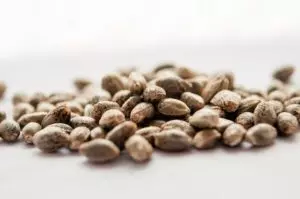Everywhere in the world, people have heard of cannabis. In fact, many of these people refer to it as weed, a word that denotes a plant that can grow anywhere, notwithstanding modern cultivation methods.
It is because of its name – weed that makes cannabis a versatile crop. As such, you can expect weed to grow anywhere from swampy places to arid areas where you may need occasional watering to keep your marijuana thriving.
Because there are many methods of cultivating weed, it is important you know which of the methods is suitable for you. This guide will, however, discuss one of the main ways of cultivating cannabis. The method is referred to as hydroponics. What is hydroponics? What do you need to grow your weed hydroponically? Are there any advantages of growing your weed using hydroponics? If yes, what are the benefits? Should you beware of any side effects of growing your weed using this method? This article looks into those and other questions.
What is hydroponics?
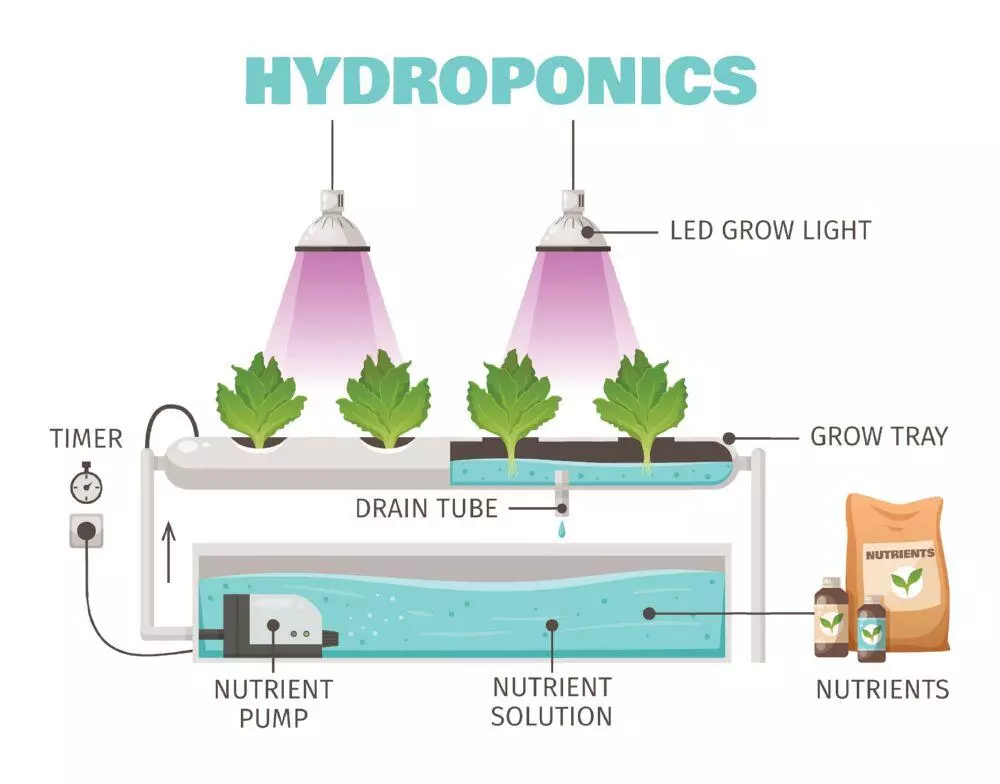
When used in the growing of cannabis, the term hydroponics refers to a system or method of growing weed using water and a few nutrients. The method is different from cultivating weed on soil that is filled with various nutrients that, to many people, are important for the growth of cannabis.
The interesting thing about hydroponics, which in part means water, is the method involves the watering of weed that is grown in pots or any other vessels rather than those grown directly into the soil.
However, it is important to note from this point that hydroponics is not a shortcut. In essence, it is not a simple way of cultivating weed. In fact, hydroponics is quite involving. The method involves sophisticated systems. These systems require you to use high-end pumps, reservoirs, timers, and other heavy pieces of machinery that may require daily hard daily labor.
Besides, the whole system requires constant maintenance, failure to which part or the whole plantation may lack water due to poor fixing, drainage, and mechanical and technical work.
One has to put a lot of initial income, labor, and workforce to the project. In addition, setting up a complete hydroponic system may require a lot of time. Nonetheless, it works if done properly and with a substantive amount of resources.
With that intro on what hydroponics is, what is involved in setting up the system, and the amount you may need to set up complete hydroponics, it is time we delve into more subtle things.
Materials for carrying out DIY cannabis hydroponics
By now, I’m sure you are ignited, and you want to try this method of growing cannabis. If so, let us sample some of the things that you may need. Some of the things in the list below may be locally available, while you may have to look for others from a store near you.
- Pump
- Lighting hangers
- Lighting LED/HPS
- Carbon filter
- Grow tent
- Cannabis seeds
- Tray
- Hydroponic reservoir
- Oscillating fan
- Planting pots (preferably net meshed)
- Growing medium (preferably coco coir)
- Ducting tubes
- Ventilation fan
- PPM and pH meters
- Hydroponic nutrients
- Hydrometer
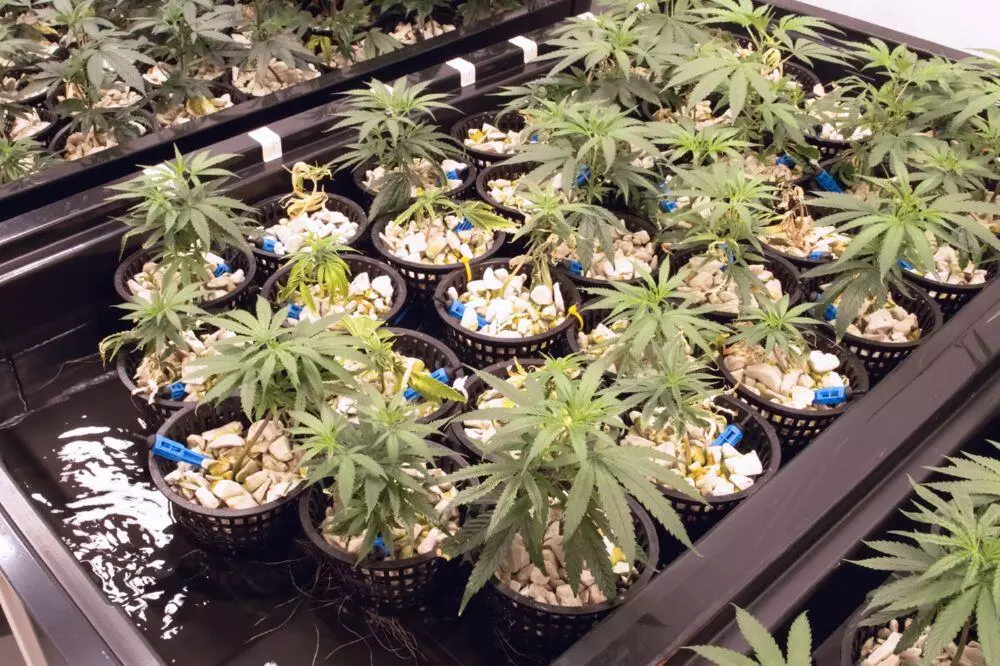
Choosing the right growing medium is important (soil alternatives)
Now that you have what it takes to set up the hydroponic weed growing system in your home let’s see if you need anything else before you set the system up and running.
The first thing you need to look for when starting up is a weed growing medium. A medium is a very crucial element in the hydroponic system of growing weed. This is a substance whose work is to hold the plants’ roots and stems into place, which is normally done by the soil.
It is from the intersection that the plants’ roots will start to grow towards the water below in search of the essential nutrients. Thanks to the inert medium, there will be plenty of airflows, especially to reach the upper side of the roots.
Cultivators use different types of mediums. It is up to you to decide the type of medium that works best for you. Each of the available mediums has its distinctive features and benefits over the other.
Before you settle on a particular medium, you are perhaps going to try several. No matter how long it will take you, the most important thing is you get a medium that will help you reap the best results.
Here are some of the common mediums you can consider, as a substitute to soil (in some aspects):
Clay Pebbles

Perhaps you’ve come across this medium in your research. Clay pebbles are one of the mediums that are commonly used. The medium stands out because of the excellent aeration that it offers plants. The medium features large pebbles that allow for constant airflow at the root area.
The medium may occasionally require that you alter the soil pH, something that offers optimum growth to the plants. Some shrewd cultivators buy pebbles whose pH is already altered.
After buying or looking for the pebbles, you need to place them inside a bucket that has holes at the bottom.
Perlite

Perlite is a volcanic glass with unique features that allow it to expand whenever the temperature is high. The medium is good in garden soils because it provides the necessary aeration. Because hydroponic weed needs proper aeration, Perlite becomes one of the commonly used mediums.
Rockwool
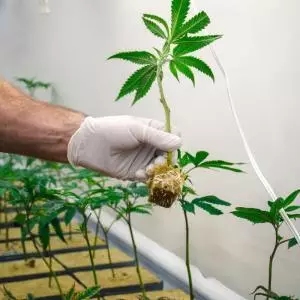
Another popular choice among hydroponic cultivators is Rockwool. Although the medium features a woolen texture, the main ingredient is volcanic rocks. It is because of the unique mixture of rocks and wool that the medium is referred to as ‘Rockwool’.
The medium’s excellent feature of holding water for a long time makes it one of the perfect hydroponic mediums around. Thanks to its water-retaining feature, Rockwool makes it possible for fast and excellent upper root formation.
You can place Rockwool inside a hydroponic bucket or lodge it directly on top of the tank or bucket without necessarily covering it with a lid.
Coco Coir

So far, many people prefer Coco coir as their right hydroponic medium. It is the most similar to soil compared to other growing mediums. The medium got it’s name from coconut fibers from which it is drawn. One of the qualities that make this medium the best is its aeration excellence.
In addition, the medium is good in retaining moisture, which is one of the essentials for hydroponic weed growth.
The medium is respected for its unique ability to protect weed roots from common infections thanks to its plant-stimulating hormones.
Assuming that you have a medium in mind, how would you now go about setting up a full hydroponic system? The following part will address that question step-by-step.
How to set up a complete hydroponics cannabis system
The first step in setting up a full hydroponic system in your garden is to fix the reservoir, a place where you will place the solution. Depending on your space, the reservoir can take any shape and come in different sizes.
You only need to ensure that the reservoir has the ability to carry the air stone as well as the water pump. Make sure you create lines joining the water pump and the reservoir. Besides, there should be a line connecting the air stone and the drainage system.
There should also be a power ford for the pump to function or work and the line from the pump to a drip line if any.
The next step will be setting up a grow table. This table helps a lot in regulating and holding any excess water that might be overwhelming the crops and returning it to the reservoir.
It is fundamental to ensure the grow table is not at the same level with the reservoir. In fact, it should be built at a lower level compared to the reservoir for water to flow with ease.
Install a drain at this low point and connect it with the reservoir using plastic tubing.
Back at the table, add approximately 5-gallon buckets. These buckets should have clay pellets in them. However, it is advisable that before you use the clay pellets, you should try to soak them in water for some time. If possible, soak the clay pellets in water over night before you use them the following day.
The aim of soaking the clay pellets in water is to make sure they are saturated fully in water. Your crops are going to need this water afterwards. It is also important that the buckets have holes. You can drill a few holes at the bottom of each bucket with the aim of draining excess water, which then will go to the table.
You should not make big holes for fear the clay pellets may pass through the holes thus losing the essential growing medium. Usually, it is advisable to create holes that are half or a third the diameter of the pellets.
The next step would be connecting the plastic tubing from the water pump to the growing table. To ensure each bucket gets the water, you can extend the plastic tubing and ensure you create holes on the tube.
Creating small holes on the tube should not be a problem. In fact, you can puncture the tubing using a sharp object or burn a metal grill and create the holes. At the rear end of your drip line, you can now attach emitters, commonly known as drip line emitters.
Before you bring cannabis plants, you need to test the system to be sure everything is working properly. One of the crucial things you need to ensure there should not be any stagnant water anywhere within the system.
The other thing you must ensure during your testing is the air pump should always be on. It shall not be off at least for more than five minutes. The pump- should be on to provide water with the needed oxygen.
The grow table and the five-gallon buckets on the other hand should be able to return any excessive or remaining water back to the reservoir.
If everything is okay, you now know it is time to create nutrient solution for your crops.
Unless the nutrient solution is ready, you cannot introduce your cannabis plants to the grow table.
Choose the easiest yet effective hydroponic setup
With the common growing mediums and a basic hydroponic setup, you might want to know the various hydroponic set-ups that are available. Before we delve into the various hydroponic setups, it is crucial to note that they are all similar in one thing – all the setups make use of a solution enriched with nutrients.
However, a setup can vary from another depending on things such as air circulation, the amount of moisture in the medium, temperature, and of course water exposure.
Although you can purchase most of the available setups, you can make one. You don’t have to possess unique technical skills. With a few guidelines, you can create a DIY hydroponic setup.
Having said that, let’s explore some of the available hydroponic setups you can purchase or make at home.
 Deep Water Culture
Deep Water Culture
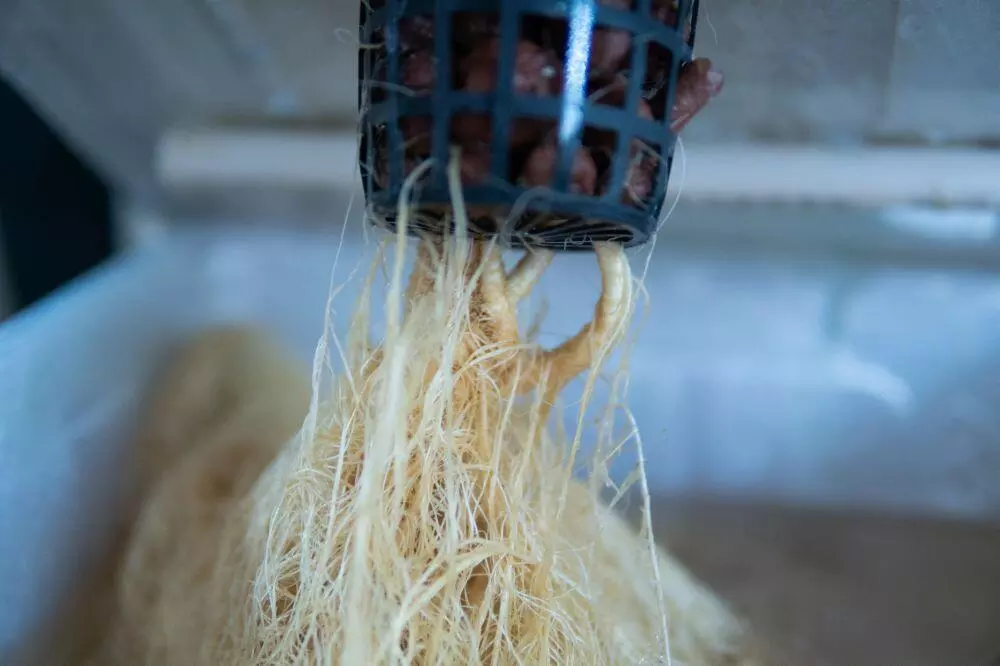
Deep Water Culture setup is good for those who are starting. In this setup, you place your cannabis plants inside buckets that already have a nutrient solution. In addition, you need an air pump, which will provide the cannabis plants with oxygen constantly.
Drip System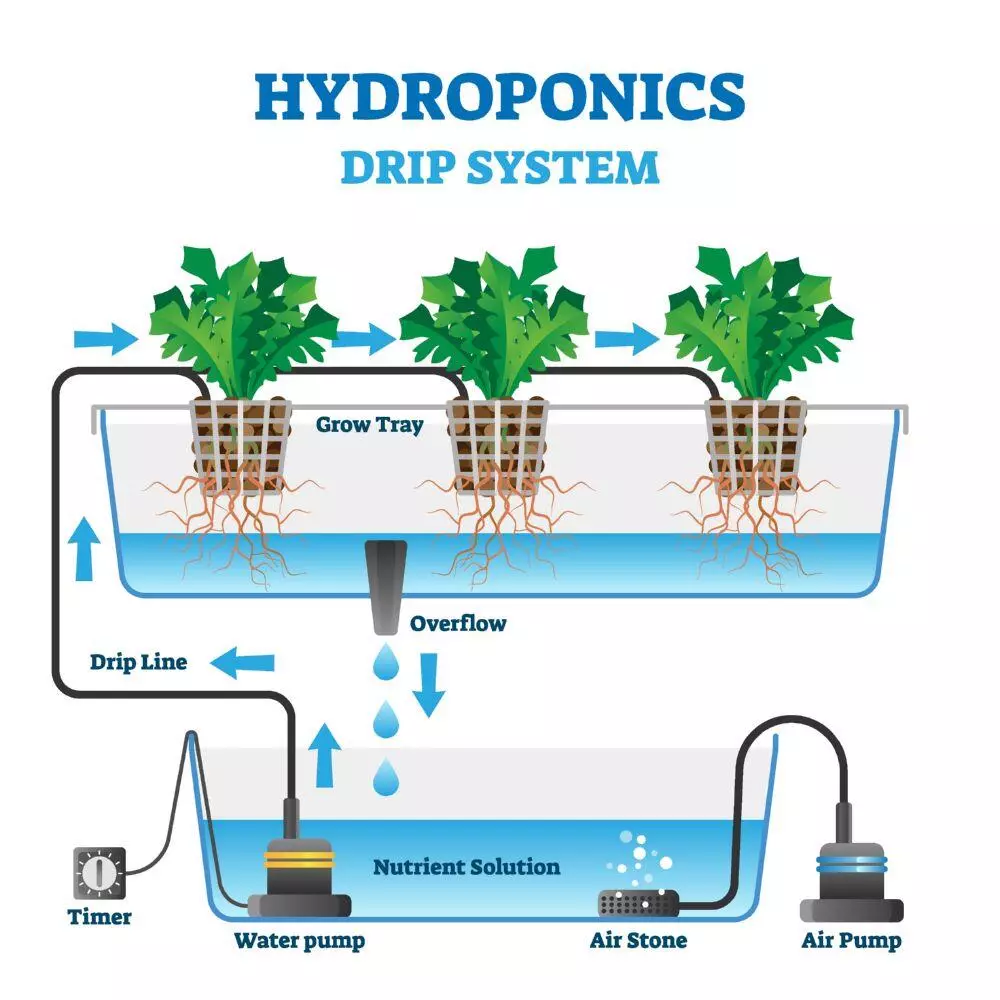
In drip hydroponic system, you will need a large tray that is full of growing medium. You remember we talked of the four different mediums earlier. Well, you are going to fill any of those mediums in the tray.
Young cannabis plants are planted into the medium directly. Each of the cannabis plant has its own drip tube or pipe. Water is kept is an external large tank. The tank is connected with air stones and a pump, which supplies each drip with oxygenated water.
Plants’ roots get sufficient air but excessive water is removed from the medium to the large external tank, which is later pumped back to the drips.
Drip hydroponic system works the same way as drip irrigation system.
Nutrient Film Technique (NFT)
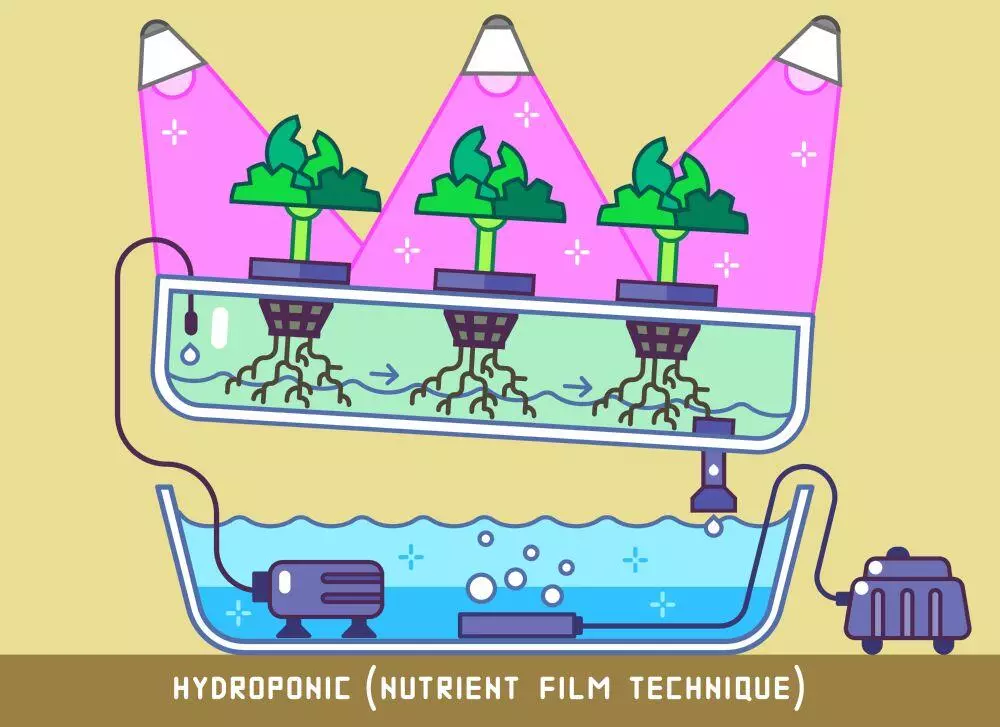
In the Nutrient Film Technique, you place a tray on top of the reservoir and tilt it. from the top downwards, you fill the tray with nutrients. You will then let the nutrients drain slowly from the tray going back to the reservoir. This circular-motioned technique allows roots to feed from nutrients slowly but surely.
In addition, the roots access air easily.
Ebb & Flow
As is the case in NFT, you will need to place a nutrient-solution inside a tray that is placed on top of the reservoir. Once the solution floods the tray, it tends to ‘ebb’ back to the reservoir. While the solu7tion is doing this back and forth movement, it continues to feed your weed’s roots that are in the tray.
Wick System
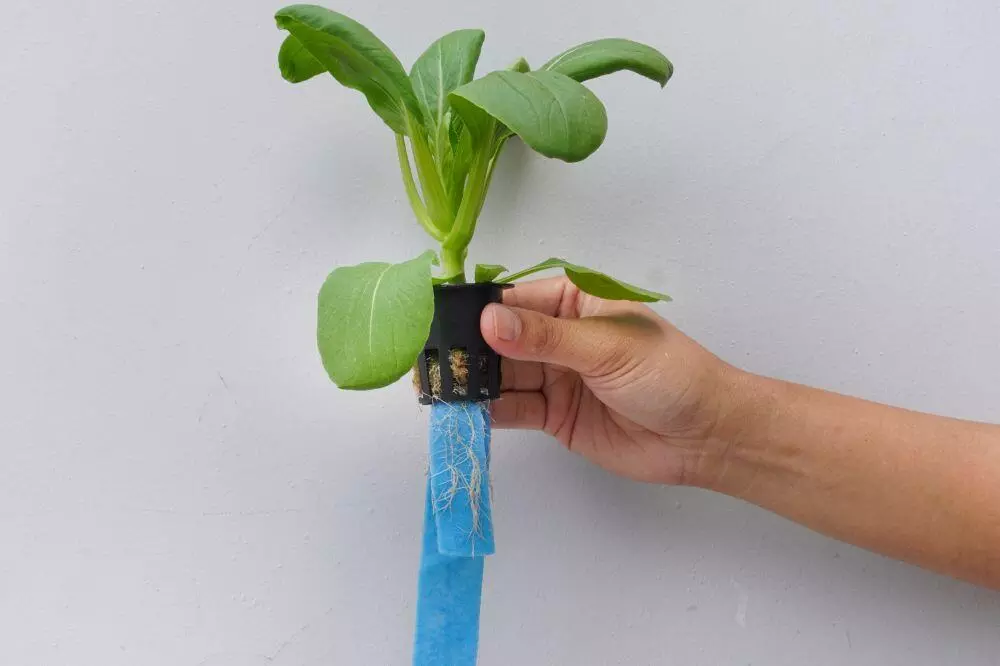
Wick system is similar to a drip hydroponic system. You fill the growing tray with clay pebbles. Immediately under the tray filled with pebbles is a tank carrying clean water. it is inside this tank of clean water that several wicks pass to the growing medium.
Water from the tank travels up inside the wicks. As the water travels up, it hydrates the medium. Although passive, the hydration is essential to the growth of the weed. You do not need a water or air pump in the Wick Hydroponic System.
Aeroponics
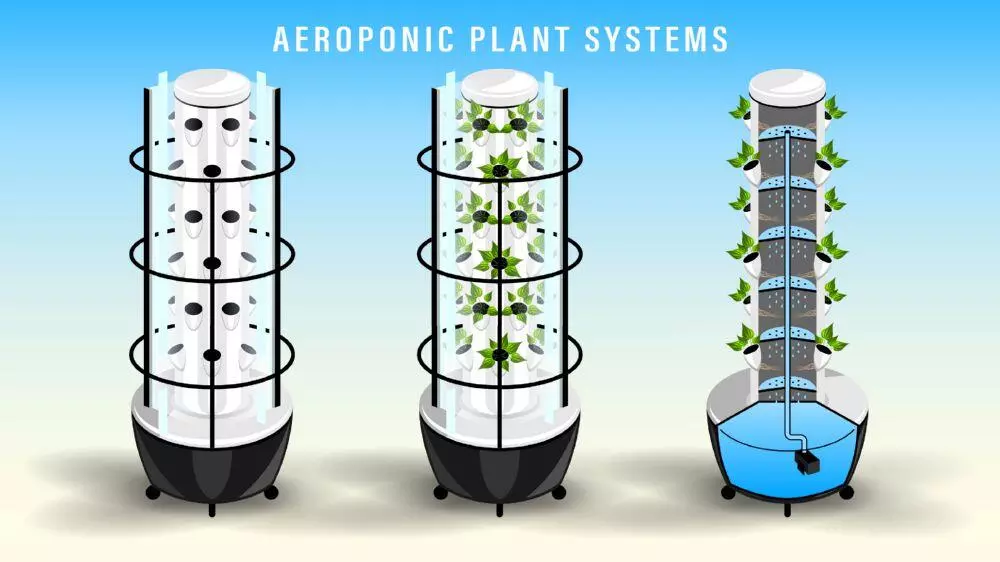
Many believe that aeroponics is a futuristic hydroponic systems weed cultivators will ever have. In this system, you utilize misted water that is dispersed in the air, something that optimizes hydration and aeration.
To make it work, you place plants on top of a water tank, which is large enough to accommodate many plants. You should fill at least 25% of the bottom side of the tank.
Under that water, you will need a strong pump, which sends water to become misters below the plants’ root system. Because mist is so fine, it has the ability to penetrate the roots to soak them, allowing the weed to receive large quantities of water and air simultaneously.
Needed nutrients to make sure your plant thrives in a hydroponics setup
One thing we must agree is that it is not necessary for cannabis or even any plant to be in soil for it to grow. The most important things needed for germination and subsequent growth are essential nutrients.
Here is a list of some of the essential nutrients needed for the growth of cannabis and any other plant in general:
Main nutrients needed for plant germination and growth also known as macroelements include:
- Potassium (K)
- Phosphorous (P)
- Nitrogen (N)
- Sulfur (S)
- Magnesium (Mg)
- Calcium (Ca)
Your plants also need small nutrients (microelements) that add value to the growth of cannabis. Some of these microelements include:
- Manganese (Mn)
- Chlorine (Cl)
- Zinc (Zn)
- Boron (B)
- Copper (Cu)
- Iron (Fe)
- Molybdenum (Mo)
With the above macro and microelements, you can grow your cannabis indoors using hydroponic system.
Depending on the size of your piece where you have established your hydroponic system, you can enjoy good growing results. Besides, you will be one of those cannabis farmers who will smile come harvest time.
Hydroponic experts advise those who are starting up to check on their nutrient balance regularly. For instance, too much of one macroelement or lack of a few or a number of microelements would be devastating.
Essentially, you will require a 15-15-15 nutrient balance. However, critics say that the balancing depends on the growth stage of your weed. The usual working nutrient-balance should be something like 15% Phosphorus, 15% Nitrogen, and 15% Potassium.
On another stage, possibly as the crops continue to advance in age, you can adjust the ratio to 5-15-20. That is 5% Potassium, 10% Phosphorus, and 20% Nitrogen.
PS: If you prefer to buy hydroponic nutrients rather than pre-mixed solutions, then it would be ideal to go for a powder as long as it dissolves in water easily. Make sure the powder you are buying is labeled
- N – Nitrogen
- P – Phosphorus
- K –Potassium
In any ratio, your plants are going to need higher amounts of Nitrogen compared to other nutrients. In addition, your plants are going to need higher amounts of Nitrogen during the vegetative stage in the event the grow room’s temperature is below 80 degrees Celsius.
However, your plants are not going to need a lot of Nitrogen during the flowering period. Instead, at this point, your weed needs lots of Phosphorus. In a nutrient-balancing ratio during the flowering period, you should try something like 15-30-15, 5-20-10, or even 2-4-3 while the first to the last number stands for N, P, and K respectively.
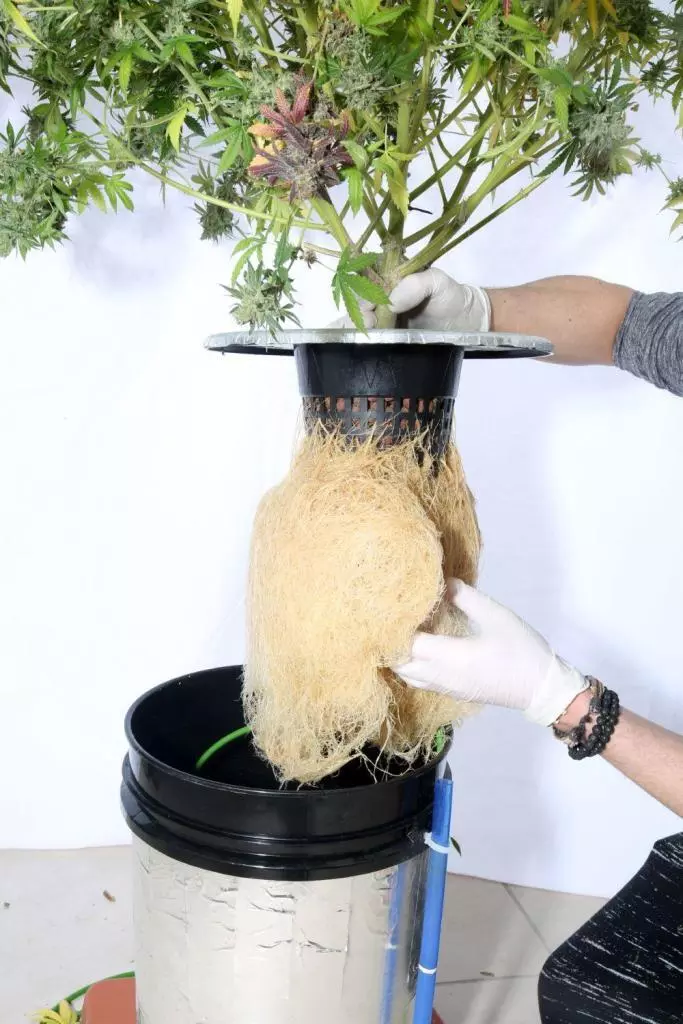
Common marijuana strains for hydroponic system
Although there could be many strains that will work with hydroponic growing system, two strains stand out.
White Widow
this strain balances its makeup. It has 50% indica and 50% sativa. It was created from White Widow S1. Perhaps, what makes this the perfect for hydroponic system is its composition as well as the growing height. When grown indoors, White Widow grows to attain a height of between 60 and 100 centimeters. Flowering period is usually between 8 and 9 weeks and you can harvest up to 500 grams per meter square.
Royal Dwarf
this is another best strain for hydroponics. It is a good option because it does not grow tall. In fact, the strain got its name ‘Royal Dwarf’ because it hardly hits 70 centimeters. In some areas, this strain can mature while attaining a height of 40 centimeters. You can harvest this strain on its eighth week of growing. Although the yield is not as much as that of White Widow, you can still harvest up to 200 grams for each square meter.
Most common mistakes
- Do not put a lot of fertilizer to your plants. Too much of it will kill the roots.
- Underfertilizing your crops will retard the growth. Although the crops will not die, they will take long to grow even mature. Besides, your cannabis will not have the strength and the vibrancy needed for cannabis of its respective age.
- If you are not certain on the amount of nutrients, you should give your crops, it would be right if you followed what is written on the nutrient package.
- Alternatively, you can try to supply fewer nutrients than giving a lot to your crops.
- Add water to the reservoir regularly. If the temperatures are high, chances of water level in the reservoir dropping fast are inevitable. Because of that, check the water level in the reservoir after two days.
- When adding water, it is advisable to add water that has stayed in the tank for more than three days.
- Change your nutrient solution every forthright. When changing the nutrient solution, you will need to do away with the old solution by draining the reservoir, the pumps, tubes and any other equipment that might have the old solution using hot water.
- Upon successful draining of the water from the tubes, pump, reservoir, and any other equipment in the system that may have contained the old water, you are free to add a new solution.
Advantages over growing cannabis in soil
There are two main advantages of growing your weed using hydroponic system:
First, if you speak to a person who has grown weed using hydroponic system, they will discourage you from trying any other growing systems. One thing is for sure – growing weed using this method is extremely fast. Yes, weed grows much faster compared to when you plant directly into the soil.
Plants grown in this system grow up to 50% faster because they do not struggle to look for nutrients. As you may have seen by now, the essential nutrients are in the water and trickle down to the roots without any barrier.
Additionally, plants do not use any energy to look and absorb any nutrients. Instead, plants preserve the energy and use it to grow to hit maturity faster.
Second, you will get large yields. It is true that you will put a lot of effort but the yields are also good. If you find a good strain and practice good hydroponic system, you will harvest great.
Final thoughts
There was a time hydroponics was reserved for those without enough space to grow their weed. That time is now gone and many people are embracing the system to plant their weed. You too can take action by studying keenly the equipment and materials needed for the job. Once you figure out what you need, go ahead and set up your own hydroponic system and you will not regret the time and effort you used in setting up the system. In the end, you will enjoy much faster growth of your weed and good yields ultimately.
Frequently Asked Questions
Is hydroponic weed bad for you?
What’s hydroponic weed?
Is hydro weed better?
How to grow hydroponic weed ebb and flow
Is hydroponic weed better than soil?
Is hydroponic weed more potent?
What does hydroponic weed mean?
div itemscope itemprop=”mainEntity” itemtype=”https://schema.org/Question”>
How to make hydroponic weed?
What size pot for hydroponic weed?
How to start hydroponic weed seeds?
- Choose your best seeds
- Immerse the weed seeds in a soaked starter cube
- Prepare the growing tray
- Ensure a suitable lit and temperature-balanced environment for germination
- Place the starter cube in the growing tray
- The seeds will germinate in a day or after a few days
- Transfer the germinated weed seeds in your hydroponic system




